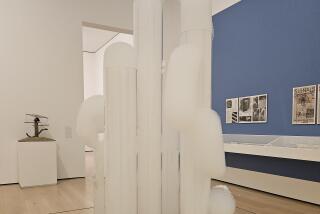Her conceptual art explored perceptions
Eugenia P. Butler, a formative figure in conceptual art who often incorporated the written or spoken word in spare exhibits that challenged people to explore how they perceive reality, has died. She was 61.
Butler died March 29 of a brain hemorrhage at Santa Rosa Memorial Hospital in Santa Rosa, Calif., said her daughter, Corazon del Sol. Butler, a longtime Los Angeles resident, moved to the Sonoma Valley four years ago to live near her only child.
“Eugenia always was an explorer. . . . She was not only a visual artist, but she was interested in the intersection of visual arts and spoken ideas,” said David Rodes, director emeritus of the UCLA Grunwald Center for the Graphic Arts at the Armand Hammer Museum in Westwood.
Her early art was often described as “invisible sculpture.” Many pieces consisted of nothing but short, descriptive wall labels meant to provoke thought, such as “Negative Space Hole” (1967) or “A Congruent Reality” (1969).
“When you read Butler’s phrases you simply feel, see and think differently in the space,” wrote Christopher Miles in Artforum International magazine in 2003.
A 35-year survey of her work was staged in 2003 in Los Angeles at the Otis College of Art and Design. Just inside the gallery, she had remade “Electric Cord Piece” (1967). Physics and electricity were a constant in her works, but no electricity flowed through the cord that snaked across the floor and looped back to the same wall, where it was plugged into another outlet.
“It’s a sculpture because of what it does inside your head,” David Pagel wrote for The Times in a review of the 2003 show.
Later works, dating from 1988, showed “greater interest in the palpable materiality of art objects,” Pagel observed. As her drawings increased in scale, they relied less on text, and color became an important part of her abstracts.
One sculpture-like work -- a 6-foot beach ball made of clear plastic -- illustrated her ability to surprise. Called “My Last Museum Piece” (2003), its interior was coated with honey to nourish the few thousand flies within.
Such art hits “you in the gut, and leaves you scratching your head,” Miles wrote, “inviting a whole range of associations.”
Provoking discussion was a hallmark of her work.
Her ongoing “Book of Lies” project, begun in 1991, examined how other artists use “the lie to explore our relationship with the truth,” according to its project history. She had completed three of four planned volumes, with images and poetry by about 70 artists. Among the contributions: a simple image of the word “Watergate” and a letter musing on how Californians live in an unsustainable desert while drinking imported water.
“They are a wonderful survey of famous and obscure, young and old artists,” Rodes said of the “Book of Lies” portfolios, which are in the Armand Hammer collection. “She knew the world of the arts, nationally and internationally.”
Sometimes the dialogue Butler instigated was her art.
When the “Book of Lies” was exhibited last year at the 18th Street Arts Center in Santa Monica, three private dinners were staged in the gallery. Guests were expected to engage the questions “What is the lie in which I am most complicit, and what is the truth that most feeds my life?”
In 1993, Butler invited a slate of well-known artists to participate in “The Kitchen Table,” a series of arts discussions that aired live on television monitors at Art/LA93, an international art fair at the Los Angeles Convention Center. “The kitchen table was where most of life’s really important conversations took place,” Butler once said. “It’s where a lot of great ideas were born.”
Eugenia Perpetua Butler was born Jan. 30, 1947, in Washington, D.C., to attorney James Butler and his wife, Eugenia. Her mother helped legitimize conceptual art and ran the cutting-edge Eugenia Butler Gallery from 1968 to 1971.
After earning a bachelor’s degree in art at UC Berkeley, Butler took her infant daughter to Ecuador. She traveled through South America for eight years in the 1970s and studied shamanism.
“She was really trying to understand the deep roots of consciousness” that would influence her work, said M.A. Greenstein, organizing researcher of the 2003 Otis show.
Some of Butler’s art reflected “a fascination with organ donation,” her daughter said, and upon her death, Butler’s kidneys and liver helped save three lives.
In addition to her daughter, Butler is survived by eight siblings.
A memorial service will be held at 3 p.m. May 10 at the William Andrews Clark Memorial Library at UCLA, 2520 Cimarron St., Los Angeles.
--
More to Read
The biggest entertainment stories
Get our big stories about Hollywood, film, television, music, arts, culture and more right in your inbox as soon as they publish.
You may occasionally receive promotional content from the Los Angeles Times.











